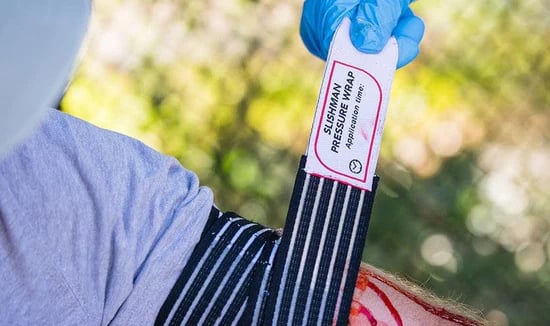Why I Prefer To Use Direct Pressure First
A guest blog from US Emergency Physician, Dr Sam Slishman
FIRST AID
Dr Sam Slishman
3 min read


In the late 90's tourniquets weren’t popular. We were taught to only use them as tools of last resort, and you would find them mostly on museum shelves. As a med student and emergency medicine resident, the “ABCs” were drilled into my head. Airway, Breathing, Circulation was the order of operations in medicine… a bit like “PEMDAS” is used in maths for Parenthesis, Exponents, Multiplication, Division, Addition, Subtraction… or Please Excuse My Dear Aunt Sally.
However, the wars in Iraq and Afghanistan, as well as US civilian shootings, led to increased attention to bleeding. It became clear that it makes no sense blowing air into lungs that have no blood. So the acronym changed from ABC to “MARCH” for Massive haemorrhage, Airway, Respirations, Circulation, Hypothermia/Head Trauma. Tourniquets regained popularity and now you’ll find them in the pockets of prepared civilians, at the movies and in grocery stores in the US.
For the past 20 years, I’ve been thinking about the most effective ways to control major bleeding and the use of tourniquets by untrained civilians. While I think tourniquets have saved lives, I also worry that their use by the general public can cause harm as well
Used correctly, they stop all blood flow to a limb. Used incorrectly, they only stop venous return and can actually increase blood loss. Plus, cutting off blood flow to a limb is also incredibly painful.
In a 2012 study of 79 tourniquet applications on the battlefield, 83% were found to have palpable pulses.
https://pubmed.ncbi.nlm.nih.gov/23536455/ To me, this is very concerning because it represents a level of harm that was being done for 83% of those injured. Also, it is worth noting that in this study, those who applied the tourniquets were highly trained medical professionals.
So for the general public I remain a strong advocate for teaching people to apply direct pressure first. With this approach there’s no need to work out whether the bleeding is life threatening, coming from an artery, or determine how much blood has been lost.
If you see blood, apply pressure. This works for kids, grandmas and every level of first aid provider. It may not stop all bleeding, but slowing the flow still has value. It allows for clotting and vasospasm, and buys the patient time. For an added bonus, If you start with direct pressure and the bleeding stops, you can back off the pressure and make the patient more comfortable.
I’m not saying that tourniquets have no place in bleeding control. But for me, I reserve them for partial or complete amputations, as well as mangled limbs. For any other bleeding, I think targeted direct pressure offers the best balance of simplicity, speed, kindness and risk minimisation.
Dr Sam Slishman MD


Sam Slishman loved physics and maths in college, then he took a hard left to start medical school back in 1993. He completed his training in emergency medicine in 2000, then worked in a wide variety of settings over the years, including a 3 month stint in Burnie, Tasmania, which changed his life for the better in many ways.
Throughout his career Sam has been a 'tinkerer', and that has led to him bringing a variety of medical devices to the market, including traction splints for broken femurs and pressure wraps for sprains, strains and bleeding control. Sam also offers home visits and telemedicine services through a company he started with his wife called Pre-R.
Sam has been the chief medical officer for Rescue Essentials since 2012 as well. However, chasing his two boys around is his primary focus nowadays.
Have you signed up to receive our newsletter and product updates? Click here to join the journey!